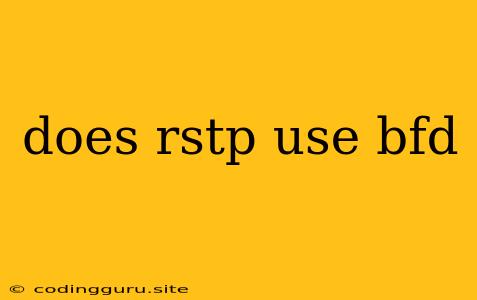Does RSTP Use BFD?
The question of whether RSTP (Rapid Spanning Tree Protocol) utilizes BFD (Bidirectional Forwarding Detection) is a common one, and the answer isn't a simple yes or no. It's important to understand the functionalities of both protocols and their potential interactions to determine their suitability in various network scenarios.
Understanding RSTP and BFD
RSTP is a network protocol that operates within the Layer 2 of the OSI model. Its primary function is to prevent loops in a network topology. Loops can lead to data packets being sent endlessly, clogging the network and causing performance issues. RSTP achieves this by blocking redundant paths, ensuring data traffic flows along a single, optimized path.
BFD is a Layer 2 protocol designed to detect failures in network connections. It works by exchanging special packets called control packets between network devices. If these packets stop being exchanged, it indicates a potential connection failure. This rapid detection allows for quicker recovery and minimizes the disruption caused by link failures.
How BFD Works with RSTP
While RSTP doesn't directly utilize BFD, they can be complementary technologies in certain network scenarios. BFD can enhance RSTP by providing a faster mechanism to detect link failures, especially in situations where RSTP's default timeout might be too slow. This can be crucial for high-performance networks where minimizing downtime is essential.
Consider a situation where a link fails within a bridged network. RSTP might take several seconds to detect the failure and reconfigure the network topology. By integrating BFD, the link failure can be detected within milliseconds, allowing for immediate recovery and minimizing network disruption.
Benefits of Using BFD with RSTP
- Faster Failure Detection: BFD significantly reduces the time it takes to detect link failures compared to RSTP's default timeout mechanisms.
- Improved Network Resilience: By quickly identifying and responding to failures, BFD enhances network resilience and minimizes downtime.
- Enhanced Performance: Faster failure detection and recovery translate to improved network performance, especially in critical applications.
Considerations for Using BFD with RSTP
While BFD can be a valuable addition to RSTP, it's not always necessary. The decision to implement BFD depends on the specific requirements of your network:
- Network Criticality: If downtime is a major concern, BFD can be a crucial tool for maintaining network availability.
- Link Failure Detection Time: If rapid failure detection is crucial for your applications, BFD can improve responsiveness and minimize disruption.
- Cost and Complexity: Implementing and configuring BFD might require additional resources and complexity compared to using RSTP alone.
Conclusion
While RSTP does not inherently utilize BFD, the two protocols can work together to enhance network performance and resilience. BFD's ability to detect failures more quickly than RSTP makes it a valuable addition in scenarios where minimizing downtime and maximizing performance are paramount. Whether BFD is necessary depends on your network's specific needs and the trade-offs involved.
